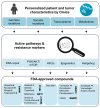Improving susceptibility of neuroendocrine tumors to radionuclide therapies: personalized approaches towards complementary treatments
- PMID: 38164150
- PMCID: PMC10750207
- DOI: 10.7150/thno.87345
Improving susceptibility of neuroendocrine tumors to radionuclide therapies: personalized approaches towards complementary treatments
Abstract
Radionuclide therapies are an important tool for the management of patients with neuroendocrine neoplasms (NENs). Especially [131I]MIBG and [177Lu]Lu-DOTA-TATE are routinely used for the treatment of a subset of NENs, including pheochromocytomas, paragangliomas and gastroenteropancreatic tumors. Some patients suffering from other forms of NENs, such as medullary thyroid carcinoma or neuroblastoma, were shown to respond to radionuclide therapy; however, no general recommendations exist. Although [131I]MIBG and [177Lu]Lu-DOTA-TATE can delay disease progression and improve quality of life, complete remissions are achieved rarely. Hence, better individually tailored combination regimes are required. This review summarizes currently applied radionuclide therapies in the context of NENs and informs about recent advances in the development of theranostic agents that might enable targeting subgroups of NENs that previously did not respond to [131I]MIBG or [177Lu]Lu-DOTA-TATE. Moreover, molecular pathways involved in NEN tumorigenesis and progression that mediate features of radioresistance and are particularly related to the stemness of cancer cells are discussed. Pharmacological inhibition of such pathways might result in radiosensitization or general complementary antitumor effects in patients with certain genetic, transcriptomic, or metabolic characteristics. Finally, we provide an overview of approved targeted agents that might be beneficial in combination with radionuclide therapies in the context of a personalized molecular profiling approach.
© The author(s).
Conflict of interest statement
Competing Interests: The authors have declared that no competing interest exists.
Figures



Similar articles
-
Real-world comparison of healthcare resource utilization and costs of [177Lu]Lu-DOTA-TATE in patients with progressive neuroendocrine tumors in England: a matched cohort analysis using data from the hospital episode statistics dataset.Curr Med Res Opin. 2022 Aug;38(8):1305-1317. doi: 10.1080/03007995.2022.2065146. Epub 2022 Apr 26. Curr Med Res Opin. 2022. PMID: 35418254
-
Safety, Pharmacokinetics, and Dosimetry of a Long-Acting Radiolabeled Somatostatin Analog 177Lu-DOTA-EB-TATE in Patients with Advanced Metastatic Neuroendocrine Tumors.J Nucl Med. 2018 Nov;59(11):1699-1705. doi: 10.2967/jnumed.118.209841. Epub 2018 Apr 13. J Nucl Med. 2018. PMID: 29653971 Free PMC article. Clinical Trial.
-
Response to Single Low-dose 177Lu-DOTA-EB-TATE Treatment in Patients with Advanced Neuroendocrine Neoplasm: A Prospective Pilot Study.Theranostics. 2018 May 12;8(12):3308-3316. doi: 10.7150/thno.25919. eCollection 2018. Theranostics. 2018. PMID: 29930731 Free PMC article.
-
Neuroendocrine Tumor Theranostics: An Update and Emerging Applications in Clinical Practice.AJR Am J Roentgenol. 2021 Aug;217(2):495-506. doi: 10.2214/AJR.20.23349. Epub 2021 Jun 2. AJR Am J Roentgenol. 2021. PMID: 34076455 Review.
-
Response to targeted radionuclide therapy with [131I]MIBG AND [177Lu]Lu-DOTA-TATE according to adrenal vs. extra-adrenal primary location in metastatic paragangliomas and pheochromocytomas: A systematic review.Front Endocrinol (Lausanne). 2022 Oct 20;13:957172. doi: 10.3389/fendo.2022.957172. eCollection 2022. Front Endocrinol (Lausanne). 2022. PMID: 36339441 Free PMC article.
Cited by
-
[18F]MFBG PET/CT is an effective and preferable imaging modality for neuroblastoma in a prospective comparison with SSTR PET.Eur J Nucl Med Mol Imaging. 2025 Jul 28. doi: 10.1007/s00259-025-07449-y. Online ahead of print. Eur J Nucl Med Mol Imaging. 2025. PMID: 40717185
-
Radioresistant mouse pheochromocytoma cell lines.Front Oncol. 2025 Jul 30;15:1517132. doi: 10.3389/fonc.2025.1517132. eCollection 2025. Front Oncol. 2025. PMID: 40809026 Free PMC article.
-
Tumoricidal Activity and Side Effects of Radiolabeled Anti-NCAM [131I]-Iodine-ERIC1 in Neuroblastoma-Bearing Mice.Int J Mol Sci. 2024 Oct 5;25(19):10737. doi: 10.3390/ijms251910737. Int J Mol Sci. 2024. PMID: 39409066 Free PMC article.
-
Molecular imaging of neuroendocrine tumors: Current applications and future trends.Diagn Interv Imaging. 2025 May 21:S2211-5684(25)00103-2. doi: 10.1016/j.diii.2025.05.005. Online ahead of print. Diagn Interv Imaging. 2025. PMID: 40404554 Review.
-
Theranostics for Neuroblastoma: Making Molecular Radiotherapy Work Better.J Nucl Med. 2025 Apr 1;66(4):490-496. doi: 10.2967/jnumed.124.269121. J Nucl Med. 2025. PMID: 39978816 Free PMC article.
References
-
- Hofland J, Falconi M, Christ E, Castano JP, Faggiano A, Lamarca A, European Neuroendocrine Tumor Society 2023 guidance paper for functioning pancreatic neuroendocrine tumour syndromes. J Neuroendocrinol. 2023: e13318. - PubMed
-
- Frilling A, Modlin IM, Kidd M, Russell C, Breitenstein S, Salem R. et al. Recommendations for management of patients with neuroendocrine liver metastases. Lancet Oncol. 2014;15:e8–21. - PubMed
-
- Auernhammer CJ, Spitzweg C, Angele MK, Boeck S, Grossman A, Nölting S. et al. Advanced neuroendocrine tumours of the small intestine and pancreas: clinical developments, controversies, and future strategies. Lancet Diabetes Endocrinol. 2018;6:404–15. - PubMed
Publication types
MeSH terms
Substances
LinkOut - more resources
Full Text Sources
Miscellaneous

